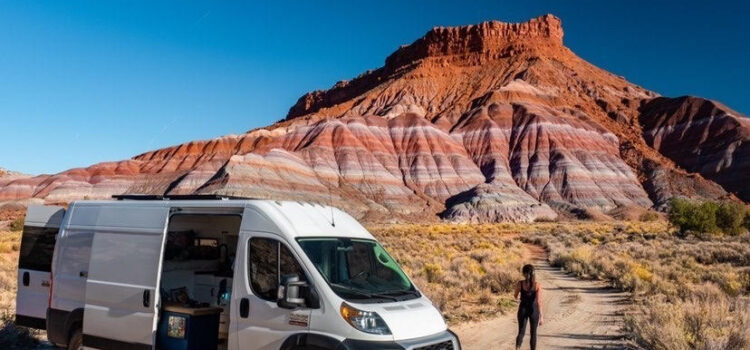
This is a joint article between Brooke Around Town and The Finance Blogger.
Hi Brooke! Nice to chatting with you
BB: Thanks for inviting me to contribute, Zach!
Tell me more about why you joined the van life?
BB: I’ve spent the last decade travelling the world as a backpacker— staying in hostels (and even sleeping on the occasional park bench) to save money, living out of a backpack for months on end, and then returning home to work and save money for the next adventure. I loved experiencing the world this way, the complete lack of frills or creature comforts, but vanlife was an opportunity to experience the world in a totally new way— and it came at exactly the right time for me.
Since finishing my PhD at the end of 2019, I’ve been saving for a round-the-world trip, working 60hrs/week at multiple universities, living well beneath my means, and squirreling away as much as 80% of my paycheck for travel. COVID imploded all my plans (including non-refundable flights to Italy), but I continued saving until September 2020, when I sold everything in Melbourne, flew to Seattle with all my earthly possessions in 2 suitcases, and set out on a roadtrip across the southwest. This was designed to be a COVID-friendly trip that would occupy me until borders opened for my fantasy RTW trip, but it ended up being a better adventure than I ever could have hoped. I fell in love with the feeling of road-tripping (something I’d never done for more than a couple weeks at a time)—the complete freedom of waking up every day and choosing your own itinerary without regard for bus or train schedules, the ability to get off the “beaten path”, and of course the luxury of having seemingly unlimited hiking gear, camera equipment, and outfit changes with me all the time.
When I met my now-boyfriend in Joshua Tree towards the end of the year, during his own cross-country road trip, it felt completely natural that we should buy a van and keep doing what we were already doing—only with more comfort (a van vs a car) and a more ambitious route (through Central America). So, to answer your question, I sort of fell into vanlife—and it ended up fulfilling me in ways I couldn’t have imagined, the perfect hybrid between home and away, routine and spontaneity, living cheap and living really, really BIG.
Did you save up money for the van ahead of time?
BB: Since I’d been saving for a multi-year RTW trip when I decided to buy a van (and Dan is a semi-responsible adult), we already had the savings necessary for such a large purchase and didn’t need to save specifically for the van. Before I divulge exactly what we paid, though, let me qualify it with a few things.
Firstly and most importantly, we did not convert our own van. All the insulation, the electrical system, the plumbing, the cabinetry, the counter, the bench seat… it was ALL built by a couple who owned the van before us. They did an amazing job and we genuinely couldn’t be happier with our van. It would have been cheaper to do it ourselves, but we were eager to get on the road without any of the construction.
Today, you’d pay $42-50,000 for a low-mileage 2019 Dodge Ram Promaster 159” like ours straight from the dealership (pre-conversion). It’s insane how expensive vans have become lately, considering the previous owners only paid $38,000 for our van last year (when it was even newer than it is now!).
Based on records from the last owners, we also know they spent $15,000 converting the van, which included a $4,800 600W solar & 300Ah lithium battery system, $1,000 composting toilet, and $700 fridge, among other things.
In total, we paid $67,000 for our fully converted van & we know we got an awesome deal. Since then, we’ve spent about $3,000 on small upgrades like an AC unit, storage bins, cookwear, and general house furnishings (plants, bedding, new cushions), so we’d value our van closer to $70,000 exclusive of contents. And we were able to pay for all of this with savings, which means we have zero accommodation expenses on the road!
How long have you been in the van? How long do you plan to do van life?
BB: We’ve been living and travelling full-time in the van since early March 2020, so about 8 months thus far—and we love it! Ideally, we will be driving all the way to Patagonia over the next 1.5-2 years, but we’ve also discussed the possibility of extending the trip if funds allow.
What is the true cost of van life and how do you keep your costs low?
BB: There’s certainly no one-size-fits-all budget for vanlife— it varies widely depending on how much you’re actually travelling, what kind of camping you’re doing, the condition of your van, what activities you’re into, where you are in the world… but this should give you a rough idea of what it costs to travel full-time in the US.
Below is our average spending PER MONTH for 2 people averaged over the last 8 months, which works out to a cool $28USD per person per day or just under $200 per week!
Accommodations: $26
We haven’t stayed at a single paid campsite since moving into the van, but have occasionally indulged in a hotel using reward points—for example, on day 14 of not having showered indoors! We’ve gotten many of these hotel rooms entirely free through points earned by staying at the hotel previously (e.g. buy 2 nights, get 1 free) and others discounted as low as $16 through Choice Hotels’ reward program (which includes Quality Inn, Comfort Suites, Rodeway Inn, etc). Often, the company will run specials to purchase their points at a discounted rate, and it can be a great way to snatch a hotel room for what is less than half of list price. We always watch for specials and deals, and make sure to coordinate our infrequent stays with the best reward value.
Activities: $244
This category includes park fees and permits ($41), gear hire (e.g. kayak rental or boots for The Narrows; $29), brewery flights & wine tasting (we’ve visited over 100 breweries on our trip!; $104), and tours or other entry fees ($70). If we were truly just “living” in our van rather than travelling, spending in this category would be substantially less, but we prioritise special experiences over a stringent budget.
Eating out: $343
We love arriving into a new town and trying their best local restaurant, so we definitely spend a fair bit of money on take-away— about $40 each per week. This is one of the expenses that we could easily trim down to save money, but again, we aren’t on a super tight budget and it ultimately just makes me happy!
Groceries: $529
Even with our love for taco trucks and pizza joints, I do heaps of cooking in our van ($313) and we also love a fancy drink after a long hike ($177)! This category also includes van consumables like toilet paper or propane for our heater ($27), and hygiene items like toothpaste or sunscreen ($12).
Personal expenses: $106
This category includes things like our Garmin In-Reach subscription ($14), health and wellness expenses like probiotics or athletic tape ($16), laundry ($4), my Lightroom CC subscription and cloud storage ($10), phone and hotspot data ($60), and public showers ($2).
Transportation: $345
We’ve travelled 15,000mi across 11 states in the last 8 months, so fuel represents one of our most significant costs. If we were trying to save money, one of the easiest ways would simply be travelling a bit slower and staying in each place longer!
Van maintenance: $125
Typical monthly costs include auto insurance ($71), content insurance ($10), and routine maintenance like oil changes ($44). To an extent, these expenses are pretty fixed, but Dan’s superpower is finding coupons for everything—we recently got an oil change at the dealership for $33! There are definitely ways to save money here, but we never skimp on quality maintenance for our van, since we know a breakdown in the middle of the desert would be far more costly.
For a more detailed cost breakdown of Brooke’s monthly vanlife expenses and other money-saving tips, check out this post on her blog.
What makes vanlife appealing financially?
BB: Vanlife presents a completely unique opportunity to travel for no more than the lowest, most basic cost of living. What you spend on activities and trail permits as a traveller, you more than make up for by having no rent or utility bills, and we’ve consistently found that we spend less now than we ever did living in an apartment and going to work. Ultimately, vanlife makes the possibility of full-time travel not only feasible for the average person but also sustainable long term!
It took me only 8 months of full-time work to save the money for my half of our $70,000 van and a projected 3 years of living/travel expenses. Since I’m now working 1 day/wk and paying for nearly all of my weekly expenses without dipping into savings, I may even be able to live longer in the van. I never dreamed that vanlife, a fantasy for so many people, could be this attainable—but it really is! And I’m so excited I found it.
Curious to learn more?
Brooke with Brooke Around Town has amazing resources on her website. I love reading her new blog posts about her vanlife adventures. If you want to learn more, I highly recommend you check out her blog!
Conclusion
You can decide what you want to do with your life. Some people enjoy early retirement on a beach, and others embark on their own version of early retirement in a converted van. If you’ve been thinking of joining this community, learning about the true cost of vanlife can help direct savings goals and lifestyle choices that ultimately bring you closer to the possibility of hitting the open road in your own tiny home. And the cost is far cheaper than I ever thought!
With all decisions, including vanlife, make sure you are financially prepared. Your financial future is up to you and only you. What are you going to do about yours?
Until next time,
Zach


